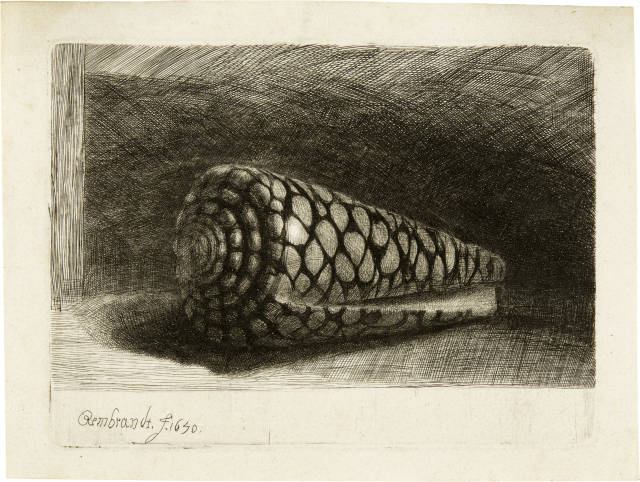- EN
Log in
- Live Auctions
- Past auctions
- More
- Gallery
- Art Dealing
- Publishing
- Kornfeld today
- The Story of Kornfeld
- Information




Leiden 1606 - 1669 Amsterdam
1650
Etching, engraving and drypoint on laid paper, possibly with parts of the watermark "Foolscap with Five-Pointed Collar", Hinterding watermark (vol. II, p. 288 and vol. III, p. 224)
11.6x15.4 cm, sheet size
The New Hollstein (Hinterding/Rutgers) 247/II (of III)
White/Boon 159
Probably Collection Thomas Carlyon (ca. 1755-1830), Tregrehan House, Cornwall
Collection Tristam Carlyon, Esq. (1877-1957)
P. & D. Colnaghi & Co, London, with the R inventory number R541 assigned by Colnaghi for this purchase
Collection Walter J. Johnson, sold at the
Christie's auction, New York, 13 May 1997, lot 48
Private collection USA
Superb impression of this rarissimum. Apart from a small supported tear in the upper margin outside the image and the old traces of folding on the verso in quite excellent condition. The few pale brown tints, which do not affect the overall impression in any way, only confirm the untouched condition of the sheet. Since the last sale of this impression 27 years ago, no other copy of comparable printing and conservation quality has been offered on the auction market
In the only still life in his graphic oeuvre, Rembrandt depicts an exotic cone snail (conus marmoreus). Rare shells and snails were coveted collectors’ items in the Netherlands in the 17th century. They arrived in Europe on the ships of the trading companies from distant lands. Contemporaries admired the beauty of nature in such objects, which they placed alongside that of art. Both stood side by side in the cabinets of art and curiosities. In the Netherlands in the 17th century, such cabinets of curiosities were created not only by aristocrats, but also by citizens and artists. As the inventory of his possessions from 1656 shows, Rembrandt himself had numerous shells and snails in his collection.
In his depiction of a cone snail from the Indian Ocean, Rembrandt was not interested in a scientific reproduction as Wenzel Hollar did in his series of 39 snails and shells (The New Hollstein 1273-1311). For example, Rembrandt reproduced the surface structure of the snail with great accuracy, but did not take into account the anti-clockwise structure of the snail shell. The artist seems to have been primarily interested in the play of light and shadow, as if he wanted to prove that art is capable of competing with nature.
While the snail in the first state casts a shadow but is depicted against a completely white background, the second state shows it lying on a shelf against a shaded background.
1650
Radierung, Kupferstich und Kaltnadel auf Bütten mit wohl Teilen des Wasserzeichens "Fünfzackige Schellenkappe", Hinterding Wasserzeichen (Band II,
11,6x15,4 cm, Blattgrösse
The New Hollstein (Hinterding/Rutgers) 247/II (v. III)
White/Boon 159
Wohl Slg. Thomas Carlyon (ca. 1755–1830), Tregrehan House, Cornwall
Slg. Tristam Carlyon, Esq. (1877–1957)
P. & D. Colnaghi & Co., London, mit der von Colnaghi für diesen Kauf vergebenen R-Inventarnummer R541
Slg. Walter J. Johnson, verkauft an der
Auktion Christie’s, New York, 13. Mai 1997, Los 48
Privatsammlung USA
Superber Abdruck dieses Rarissimums. Von einem hinterlegten Risschen im oberen Rand ausserhalb der Darstellung und den alten Falzspuren verso abgesehen in ganz ausgezeichnetem Zustand. Die wenigen blassen und den Gesamteindruck in keinster Weise beeinflussenden Brauntönungen bestätigen nur die Unberührtheit des Blattes. Seit der letzten Veräusserung dieses Abdrucks vor 27 Jahren ist kein Exemplar von vergleichbarer Druck- und Erhaltungsqualität mehr auf dem Auktionsmarkt angeboten worden
Im einzigen Stillleben seines graphischen Werks zeigt Rembrandt eine exotische Kegelschnecke (conus marmoreus). Seltene Muscheln und Schnecken waren in den Niederlanden des 17. Jahrhunderts begehrte Sammelobjekte. Sie gelangten mit den Schiffen der Handelskompanien aus fernen Ländern nach Europa. Die Zeitgenossen bewunderten in solchen Objekten die Schönheit der Natur, die sie neben die der Kunst stellten. Beides stand in den Kunst- und Wunderkammern nebeneinander. In den Niederlanden des 17. Jahrhunderts wurden solche Kunstkammern nicht nur von Adeligen, sondern auch von Bürgern und Künstlern angelegt. Wie das Inventar seines Besitzes von 1656 belegt, besass Rembrandt selbst in seiner Sammlung zahlreiche Muscheln und Schnecken.
In seiner Wiedergabe der aus dem indischen Ozean stammenden Kegelschnecke ging es Rembrandt nicht um eine naturwissenschaftliche Wiedergabe wie Wenzel Hollar sie in seiner Folge von 39 Schnecken und Muscheln unternahm (The New Hollstein 1273–1311). So gab Rembrandt etwa mit grosser Genauigkeit die Oberflächenstruktur der Schnecke wieder, berücksichtigte aber nicht den gegen den Uhrzeigersinn gerichteten Aufbau des Schneckenhauses. Was den Künstler interessierte, war anscheinend vor allem das Spiel von Licht und Schatten, als wolle er beweisen, dass die Kunst es vermag, sich mit der Natur zu messen.
Während die Schnecke im I. Zustand zwar einen Schatten wirft, aber vor einem gänzlich weiss gelassenen Hintergrund dargestellt ist, zeigt sie der II. Zustand auf einem Regalbrett vor einem verschatteten Hintergrund liegend.
| Switzerland | CHF | 115 |
| Europe | CHF | 185 |
| Overseas | CHF | 235 |





